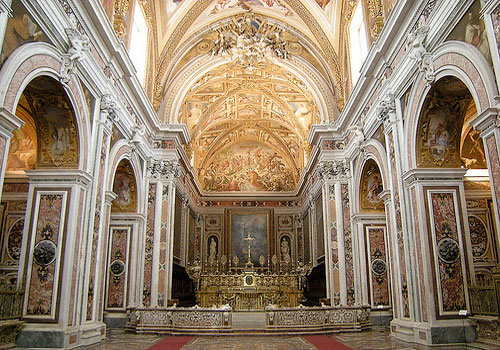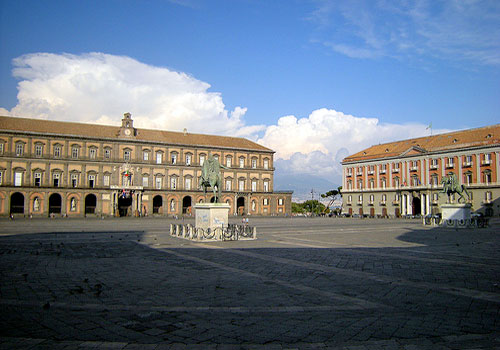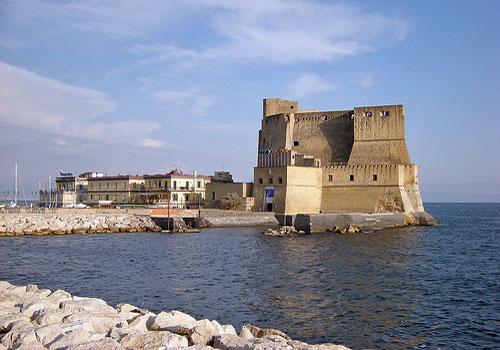Naples Travel Guide
Museo Archeologico Nazionale
Address: Piazza Museo Nazionale 18-19 Naples
This fascinating, world-class museum houses the Farnese collection of antiquities from Lazio and Campania and the incredible treasures of Pompeii and Herculaneum. Notable among these collections are the Farnese Hercules and the Farnese Bull, the largest known ancient sculpture. On the mezzanine level is the Alexander Mosaic and at the furthest end of the mezzanine floor is the Secret Room (Gabinetto Segreto). The intriguing collection contained here showcases erotic material found in the brothels, baths, houses and taverns of Pompeii and Herculaneum. The top section of the museum houses the Campanian wall paintings, well-preserved creations attesting to a mysterious past world. These are supported by a range of artefacts, in the form of glass, silver, ceramics, rope and even foodstuffs surviving from the Campanian cities of yesteryear. The remarkable collection is housed in a 17th-century building interesting in itself. Visitors should check ahead whether all the exhibits in the museum will be open to avoid disappointment as the most popular exhibits are subject to close at any time for restoration and maintenance work. Although a popular attraction in its own right, the museum is also a worthwhile stop if you plan to visit Pompeii as so many of its treasures are stored here.<br /><br />
Duomo San Gennaro
Address: Via del Duomo 147 Naples
The Chapel of San Gennaro is accessed from the south aisle of the Cathedral of Naples. This 13th-century Gothic building is dedicated to the patron saint of the city. Tradition tells the story of how two phials of San Gennaro's congealed blood liquefied in the bishop's hand after his martyred body was transported to the church. Legend has it that disaster will strike if the blood fails to liquefy on specific festival days - the first Saturday in May, on September 19 and December 16. The liquefaction ceremony, known as the Miracle of the Blood, takes place during a special Mass in full view of the congregation. The first chapel on the right upon entry into the cathedral is dedicated to San Gennaro (also known as Saint Januarius) and holds the famous phials of blood and a silver reliquary containing his skull. Beneath the Duomo are the excavations of well-preserved Greek and Roman roads that stretch beneath the modern city. Special tours of the excavations can be arranged. Generations of wealthy Neopolitains funded the cathedral and it is a treasure trove of local history and religious iconography.<br /><br /> Visitors should be aware that there have been some incidents of pickpocketing outside of the cathedral. Entry to the cathedral is free, but there is a charge to visit the archaeological site.<br /><br />
Museo e Gallerie di Capodimonte
Address: Via Milano 2, Capodimonte Park Naples
This museum occupies a restored 18th-century palace perched on the city's hills, and its artworks are arranged by collections and not chronology. The Farnese and Bourbon rulers amassed impressive collections of Renaissance paintings and Flemish masterpieces that can be viewed along with other great works. Notable among these are Masaccio's Crucifixion, Filipino Lippi's Annunciation and Saints, Raphael's Leo X, Bellini's Transfiguration, Michelangelo's Three Soldiers and Breughel's The Allegory of the Blind.<br /><br /> The palace is an attraction in its own right and the royal apartments are beautifully decorated and preserved with their 18th-century furnishings. Capodimonte is a pleasant neighbourhood in Naples, and the park surrounding the gallery is great for a peaceful stroll after ogling the art and finery of the museum. Various rooms and sections of the museum are closed to the public periodically for maintenance but the collection is so vast that this usually hardly matters; however, to avoid disappointment, check ahead how much of the museum is open, or ask at the entrance before buying your ticket. Although the collection is fascinating, the audio guide is not amazing and perhaps not worth the additional cost.<br /><br />
Pompeii
Address: Naples
In the year 79 AD Mount Vesuvius erupted, burying the Roman city of Pompeii in volcanic lava and ash. The most evocative testimony to its victims is the 'frozen people', plaster casts of the victims whose anguished contortions and facial expressions reveal the horror of their untimely deaths. The excavation of Pompeii, which started after its accidental rediscovery in 1749, is an ongoing process and every decade has brought to light new finds that provide insight into daily Roman life. A comprehensive tour of Pompeii's attractions will take approximately five hours. Guided tours are available but are pricier alternatives to doing it alone. There is an informative 'How to Visit Pompeii' guidebook for sale outside all the site entrances.<br /><br /> Pompeii is one of Italy's most popular tourist attractions, seeing nearly 2.5 million visitors every year. It is one of the most intriguing ancient sites in the world and a full day of walking barely covers the many sights of interest. The Pompeii site has been plagued by mismanagement but has recently been granted a huge injection of funds which should improve maintenance; however, the place is so captivating that no amount of mismanagement can deter visitors from travelling to Pompeii, and the four associated sites of Herculaneum, Oplontis, Stabia and Boscoreale.<br /><br />
Paestum
Address: Campania region, southern Italy Naples
The well-preserved Greek temples of Paestum are arguably the best of their kind in the world, easily rivalling those of Sicily and Athens. The city was founded by its Greek colonists in the 7th Century BC, and later fell under Roman rule (until it was no longer commercially successful and its inhabitants fled for greener pastures). The north-south axis of the city is marked by the paved Via Sacra and most guided tours begin at its southern end. A guide to the excavations and Archaeological Museum can be bought at any of the roadside shops. Notable among the remains are three Doric temples, the best-preserved of their kind in the world. Built without the use of cement or mortar, these remarkable structures comprise the Basilica, the Temple of Poseidon and the Temple of Ceres. Heading north along Via Sacra will take one to the Roman Forum, gymnasium and amphitheatre. Finally, Paestum's Museum contains a fascinating collection of pottery and paintings found in the tombs of the area. The main temples are fenced off so you can't wander through them, but many other ruins can be explored without hindrance and the site is often pleasantly devoid of tourists, leaving visitors to explore at their leisure in peace and with remarkable freedom.<br /><br />
Capri
Address: Naples
Capri's beauty captured the imagination of the Roman Emperor Augustus in 29 BC, and continues to draw admiring crowds to its picturesque banks. Ferries and hydrofoils transport travellers from Sorrento, Positano, Amalfi and Naples to its embarkation point at Marina Grande. From here, a funicular runs to the town's Piazza Umberto. The island's main attraction is the Blue Grotto. This sea-cave is illuminated a fantastic neon blue, caused by the interplay of light and water. The ruins of Villa Tiberio can be explored following a 45-minute trek up the nearby hill. Legend has it that Tiberius tossed those unfortunate enough to anger him off the precipice; though, luckily, walking down is an option nowadays. On the descent along the path one can take a short detour to the Arco Naturale. This weathered stone arch on the island's eastern cliffs provides the perfect perspective from which to contemplate the vista that stretches to Paestum. Another interesting villa to explore is the Villa San Michele (in Anacapri), the magnum opus of Swedish author and physician Axel Munthe. Henry James described it as 'the most fantastic beauty, poetry, and inutility that I have ever seen clustered together.' Also in Anacapri, take the 12-minute chairlift to the summit of Monte Solaro to experience the breathtaking views stretching to the distant Apennines and Calabria mountains.<br /><br />
Sassi de Matera
Address: Naples
For anyone with even the smallest interest in human history, the Sassi de Matera - located in the region of Basilicata, about 156 miles (250km) east of Naples - are a must-see tourist attraction. The unbelievable cave-dwellings of Matera were inscribed in UNESCO's list of World Heritage Sites in 1993, and have been astonishing visitors to the region ever since. Dug into the tuff rock of the region (rock comprised of consolidated volcanic ash), the 'houses' are often little more than caverns, and remain as testament to a troglodyte population believed to be the first human settlement in Italy. Some of the streets of present-day Matera double as rooftops to the underground dwellings, and beneath the surface, a network of labyrinths and caverns once traversed by the prehistoric civilisation can still be observed. As has been noted, the inhabitants of Matera's Sassi are the only people who can claim to live in the same houses as their ancestors did 9,000 years ago - making these amazing structures compulsory viewing for all tourists to Italy who are keen on historical sightseeing. It's fun to hire bikes and ride to the caverns further afield and there are many good local guides to hire.<br /><br />
Blue Grotto (Grotta Azzurra)
Address: Naples
An emblematic tourist attraction, the Blue Grotto (Grotta Azzurra) is reason enough for any visitor to Naples to make the short trip across to the island of Capri. A world-famous sea cave, the Blue Grotto is perpetually filled with brilliant sapphire light, caused by sunlight entering through an underwater cavity and shining through the seawater from beneath. The cave also contains a smaller opening right at the level of the waterline, through which bright sunshine pours, and through which tourists are admitted by row-boat. Gaze in wonder at the spectral water, more light-filled than the air in the cave, and be sure to dip your hands and watch them glow an eerie silver-blue. Since row-boats entering the cave can only take a maximum of three passengers, you are ensured a private and truly unforgettable experience in the Blue Grotto, one which you will treasure for the rest of your life. Blue Grotto Tours is a popular tour company which guides trips into the mystical blue cave and has earned rave reviews from tourists. Of course, the island of Capri is beautiful and a hop across the water from Naples is worthwhile just to see the lovely landscape and experience the atmosphere of this famous island.<br /><br />
(Data provided outside US and Canada by Foreca, Data provided for US and Canada by WDT)
| Jan | Feb | Mar | Apr | May | Jun | Jul | Aug | Sep | Oct | Nov | Dec | |
| Average High | 12° | 12° | 15° | 17° | 22° | 26° | 29° | 29° | 26° | 21° | 16° | 13° |
| Average Low | 4° | 5° | 6° | 8° | 12° | 16° | 18° | 18° | 16° | 12° | 8° | 5° |
(Data provided outside US and Canada by Foreca, Data provided for US and Canada by WDT)
| Jan | Feb | Mar | Apr | May | Jun | Jul | Aug | Sep | Oct | Nov | Dec | |
| Average High | 54° | 55° | 60° | 64° | 72° | 79° | 85° | 85° | 80° | 71° | 62° | 56° |
| Average Low | 40° | 41° | 44° | 48° | 55° | 62° | 66° | 66° | 61° | 55° | 47° | 42° |
| Description Round pins. |
Voltage 230 V |
Frequency 50 Hz |
Type C |
| Description "Schuko" plug and receptable with side grounding contacts. |
Voltage 230 V |
Frequency 50 Hz |
Type F |
| Description Round pins with an inline grounding pin. |
Voltage 230 V |
Frequency 50 Hz |
Type L |



